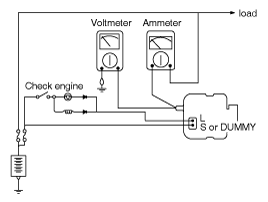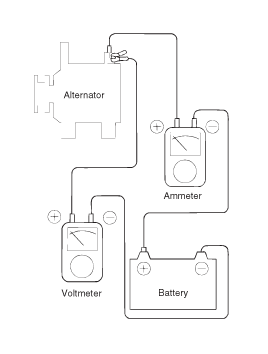 Hyundai Elantra HD: Repair procedures
Hyundai Elantra HD: Repair procedures
Inspection
Voltage Drop Test
This test determines if the wiring between the alternator"B" terminal
and the battery (+) terminal is good by thevoltage drop method.
Preparation
| 1. |
Turn the ignition switch to "OFF."
|
| 2. |
Connect a digital voltmeter between the alternator "B"terminal
and battery (+) terminal. Connect the (+)lead wire of the voltmeter
to the"B" terminal and the(-) lead wire to the battery (+) terminal.
|
Conditions For Testing
With the engine running and headlamps, blower motor etc.ON, check the
reading on the voltmeter.
Result
| 1. |
The voltmeter should read a standard 0.2V.
|
| 2. |
If the reading is above 0.2V, poor wiring should be suspected.
Check wiring from alternator 'B' terminal through the fusible
link to the battery (+) terminal.
Check for loose wiring or color change from an overheated harness.
Correct and check again.
|
| 3. |
On completion of the test, set the engine at idle.
Then turn off the headlamps, blower motor etc., and ignition.
|
Output Current Test
This test determines if the alternator gives an output currentthat is
equivalent to the nominal output.
Preparation
| 1. |
Prior to the test, check the following items and correct as necessary.
|
| 2. |
Turn the ignition switch to "OFF".
|
| 3. |
Disconnect the battery ground cable.
|
| 4. |
Disconnect the alternator output wire from the alternator "B"
terminal.
|
| 5. |
Connect a DC ammeter (0 to 100A) in series between the "B" terminal
and the disconnected output wire. Be sure to connect the (-) lead wire
ofthe ammeter to the disconnected output wire.
|
| 6. |
Connect a voltmeter (0 to 20V) between the "B" terminal and ground.
Connect the (+) lead wire to the alternator "B" terminal and (-) lead
wireto a good ground.
|
| 7. |
Attach an engine tachometer and connect the battery ground cable.
|
| 8. |
Leave the engine hood open.
|

Test
| 1. |
Check to see that the voltmeter reads the same value as the battery
voltage. If the voltmeter reads 0V, an open circuit in the wire between
the alternator "B" terminal and battery (+) terminal, a blown fusible
link or poorground is suspected.
|
| 2. |
Start the engine and turn the headlights on.
|
| 3. |
Set the headlights to high beam and the heater blower switch to
HIGH, quickly increase the engine speed to 2,500 rpm and read the maximumoutput
current value indicated by the ammeter.
|
Result
| 1. |
The ammeter reading must be higher than the limit value. If it
is lower but the alternator output wire is in good condition, remove
the alternator from the vehicle and test it.
|
| 2. |
Upon completion of the output current test, lower the engine speed
to idle and turn off the ignition switch.
|
| 3. |
Disconnect the battery ground cable.
|
| 4. |
Remove the ammeter and voltmeter and the engine tachometer.
|
| 5. |
Connect the alternator output wire to the alternator "B" terminal.
|
| 6. |
Connect the battery ground cable.
|
Regulated Voltage Test
The purpose of this test is to check that the electronic voltageregulator
controls the voltage correctly.
Preparation
| 1. |
Prior to the test, check the following items and correct if necessary.
|
| 2. |
Turn ignition switch to "OFF."
|
| 3. |
Disconnect the battery ground cable.
|
| 4. |
Connect a digital voltmeter between the "S(L)" terminal of the
alternator and ground.
Connect the (+) lead of the voltmeter to the "S(L)" terminal of
the alternator. Connect the (-) lead to a good ground or the battery
(-) terminal.
|
| 5. |
Disconnect the alternator output wire from the alternator "B"
terminal.
|
| 6. |
Connect a DC ammeter (0 to 100A) in series between the "B" terminal
and the disconnected output wire. Connect the (-) lead wire of the ammeterto
the disconnected output wire.
|
| 7. |
Attach the engine tachometer and connect the battery ground cable.
|

Test
| 1. |
Turn on the ignition switch and check to see that the voltmeter
indicates the following value.
Voltage : Battery voltage
If it reads 0V, there is an open circuit in the wire between the
alternator "S(L)" terminal and the battery and the battery (+), or the
fusible link isblown.
|
| 2. |
Start the engine. Keep all lights and accessories off.
|
| 3. |
Run the engine at a speed of about 2,500 rpm and read the voltmeter
when the alternator output current drops to 10A or less.
|
Result
| 1. |
If the voltmeter reading agrees with the value, the voltage regulator
is functioning correctly. If the reading is other than the standard
value, the voltage regulator or the alternator is faulty.
|
| 2. |
Upon completion of the test, reduce the engine speed to idle,
and turn off the ignition switch.
|
| 3. |
Disconnect the battery ground cable.
|
| 4. |
Remove the voltmeter, ammeter, and the engine tachometer.
|
| 5. |
Connect the alternator output wire to the alternator "B" terminal.
|
| 6. |
Reconnect the battery ground cable.
|



